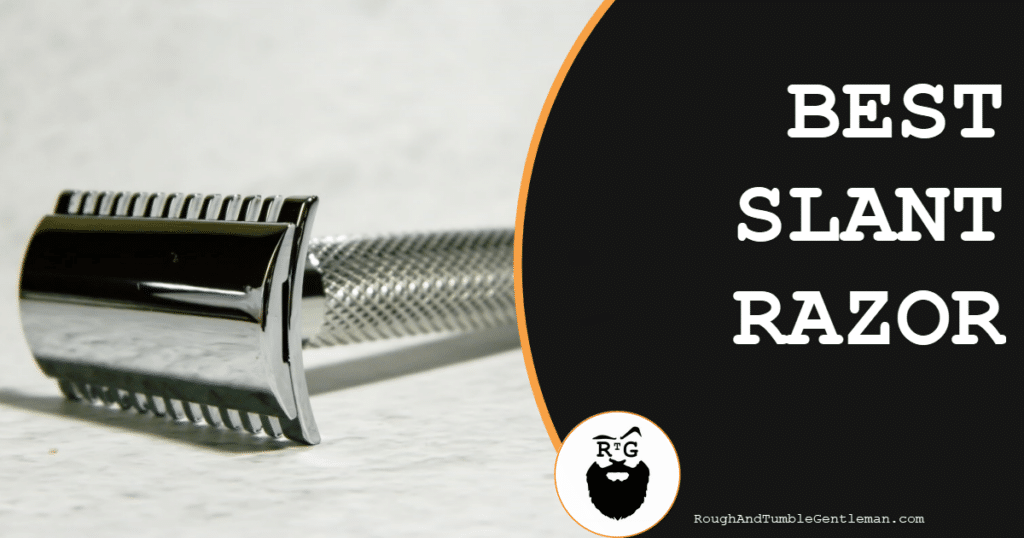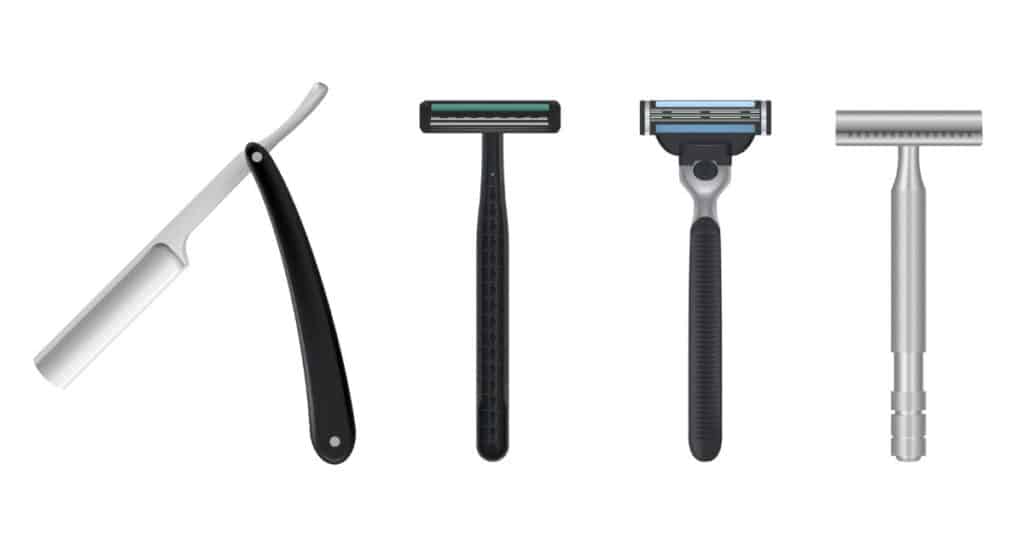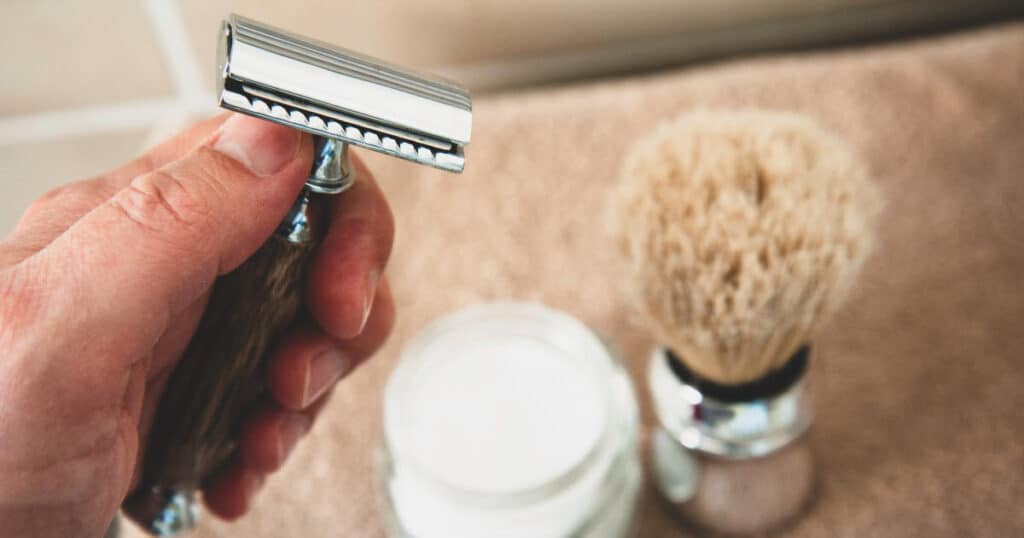We love wet shaving, but maybe we’re biased: after all, we created and dedicated an entire website to wet shaving and wet shaving techniques, so it’s clear that we’re big fans. You don’t write post after post about shaving if you’re not really into it.
But why? Why wet shave? What are the advantages over regular shaving, and using a disposable and cream from a can? Why are so many men obsessed with traditional shaving, when it seems to take a little more effort and a little more time?
We’ve searched our souls, and come up with our favorite reasons to wet shave. Hopefully a few will resonate with you. And, if you think we’ve missed a few reasons why wet shaving is *the* superior way to shave, jump down to the “Comments” section and share. Enjoy!
As for our reasons, we’ll start with the obvious:
Wet Shaving is Inherently Manly
We don’t usually get too concerned about what is considered “manly,” because as a general rule of thumb, we broadly consider anything that men do to be manly, so shaving and/or scraping facial hairs off your face is undeniably manly. But there is something inherently manly—and romantically manly—about wet shaving.
People tend to romanticize past eras, and imagine that men were more manly in the past. While that may or may not be true, it is definitely true that if you were shaving in days of yore, you were using a straight edge blade, and if you were shaving in the last 19th Century and early 20th Century, you were using a safety razor. So there is an actual traditional aspect to wet shaving, that connects you with a “by-gone” way of grooming. For a lot of guys, engaging in a traditionally manly pursuit is, in-and-of-itself, engaging and satisfying. It’s a connection to the ways that men from all over the world in all eras of time groomed themselves. There’s something universal about it, and something “classic.”
So there’s a romantic aspect to wet shaving, but there’s also an art to it. We live in a “disposable” world, wherein we’re constantly creating trash. So many of the products we use are throw-aways, and there’s very little “pride of ownership.” We’re stuck in a consistent cycle of buying cheap items, using them once or twice, and then throwing them out and buying replacements.
The tools you use to wet shave, however, are permanent, stable, and lasting. You can invest in a straight razor and use it your entire life. For all of the whiskers that come out of your face for the rest of your life, you can use the same blade to remove them. You can use it on the day of your wedding and the day of your retirement. After you pass, you can include it in your will and hand it down to your son and it can become a family heirloom. He can pass it to his son, and his to his. There’s a sturdiness to the tools that are used in wet shaving, and “sturdiness” is a trait that many of us strive for.

It’s Luxurious
We’ll talk more about this in one the “Good for Your Skin” section below, but wet shaving just feels pleasant. When you find a thick and rich craft lather you love, that smells good under your nose and feels good as you apply it to your jawline and chin, that’s a heavenly thing. And when you feel the texture of your skin after three passes—totally smooth and conditioned—shaving becomes a sensuous pleasure, instead of a chore you do before dashing off to work. It’s one of the few activities in this world that is both “luxurious” and “manly” at the same time, and that’s something to be celebrated.
Of course—we should probably mention, it feels good once you get the hang of it. Transitioning from cheap throw-away blades to safety razors takes some time and practice, and chances are very, very strong you’re going to experience some nicks and cuts (aka “weepers”) when you make the jump from cheap disposables to real-deal razors. But, hey—weathering adversity is also pretty manly.
The Gear is Gorgeous
There are plenty of men out there—not all, but a lot—who simply love gear. High-end equipment. Objects of beauty. Nice things, in other words. And if that’s you, ooooooh boy, are you going to love traditional wet shaving.
You’ve got stainless steel shaving bowls to cleverly-shaped scuttles to keep lather warm, to high-end razors made in ancient cities that have perfected the art of forging steel for blades (that would be Solingen, Germany, the “City of Blades“), to traditional soaps and lathers from the finest shops in London (that would be Taylor of Old Bond Street, Truefitt & Hill, and Geo. F. Trumper)—if you like acquiring objects of beauty, wet shaving may become a dangerous addiction for you.
It can go deep, too. Some of the more historically-minded wet shaving enthusiasts actually collect straight razors from different eras in history. Imagine waking up, showering, and then shaving your face with a straight razor that was used at the time of the American Revolution. Pretty incredible.
So those are the more “romantic” aspects of wet shaving, and there are plenty more that we’re forgetting. But there are also some pretty pragmatic aspects to wet shaving, including:
It’s Good for Your Skin
It may not come as a surprise that wet shaving provides to closest and most reliable shave: the steel that you’ll use on a safety razor or a straight razor is thinner and sturdier and simply sharper than anything you’ll find at a supermarket or bodega. It’s not difficult to prove that wet shaving provides the closest shave.
But, believe it or not, wet shaving is also considered the safest way to shave, and the way provides the most benefits for your skin:
It provides the “cleanest” shave, and that’s great for your skin. With store-bought disposable razors—even the high-end ones—there is a LOT of gunk that gets caught between the blades. When we refer to gunk, we mean dirt, bacteria, and in-general grime that’s scraped off your face. All that “gunk” is held together by your facial oils, and it sticks to the space between the blades on your disposable razor. And, let’s just say, that gunk doesn’t age well—it’s extremely irritating to the skin, and when you take that razor and scrape it across your face, over and over again, the result can be facial irritation and possible infection.
That’s not a problem for safety razors and straight razors, because you clean the blade directly, removing any gunk or bacteria that builds up. And, because the blades that wet shavers use is of a much higher quality than regular shavers, there are fewer microscopic dents and dings on the blade itself, and less gunk that collects there, as well.
It reduces the risk of in-grown hairs. Most of those multiple-blade razors you find at stores remove whiskers and facial hair using a procedure named “hysteresis.” The general idea of hysteresis is that the first razor pulls at the whisker, and the second and third razors cut the whisker deeper to the root, because the first blade has lifted it a little bit. That seems like a good idea, and in many cases it provides a decent shave, but it can actually wreak havoc on your skin. Because the first razor has pulled the whisker up, when it retracts back into the skin, it’s no longer sticking through the skin, and is instead located below the skin. When the whisker starts to grow again, it may not follow the same path to grow through the skin, and the result is itchy / irritable / red in-grown hairs. This is a problem for a lot of guys, but it most specifically affects men who have curly whiskers, that are going to grow in any direction.
Straight razors and safety razors take a different approach to whisker removal. Instead of three blades in one, wet shavers use one VERY sharp blade, and take three passes along the skin: with the grain (sometimes abbreviated as “WTG”), across the grain (sometimes abbreviated as “XTG”), and then against the grain (sometimes abbreviated as “ATG”). The three passes provide an incredibly close shave, and are very often the cure for gentlemen who experience in-grown hairs and bumps.
Less General Irritation. If you took a look at the ingredients in any of the processed foods you eat, you’re going to find some very strange-sounding words that simply cannot be natural or healthy, and the same is true for shaving creams and soaps. Check out this list of ingredients for one of the most popular shaving creams currently on the market:
Triethanolamine
Osibutane
Myristyle alcohol
Laureth-23
Propane
Hydroxyethylcellulose
Chondrus Crispus
Some… thoughts:
Myristyle alcohol is alcohol, but not the fun kind of alcohol that adults over the age of 21 enjoy. Myristyle alcohol is the bad kind of alcohol that actually dries your skin, which is an odd thing for a shaving cream to do;
Laureth-23 sounds like the Yahoo email address of some girl you knew from high school;
“Chondrus Crispus” sounds like a cut-rate Roman emperor, and it’s an actual ingredient in shaving creams, even though it sounds totally made up; and finally
Propane! Seriously—propane? Even we weren’t expecting that. Why on earth do you need propane in your shaving cream?
We really don’t know what all those chemicals do to the human body, and just because they don’t harm most people doesn’t mean they’re not generally harmful. Even if you have tough skin and don’t experience any irritation from those store-bought brands, why not use something more natural if you’ve got the chance?
It’s Good for the Earth
We spoke a little bit earlier about our “throw-away” culture. All that trash has to go somewhere, and most of the trash we create goes into a landfill, and sits there… forever. Seriously. Most of the items we use are non-biodegradable, and they sit in landfills for decades, if not centuries. When you consider that we use more than two billion disposable razors every year, it seems pretty clear: that’s a lot of trash.
Here’s another way to think about it: all those cheap disposable razors we use today will be in a landfill long after we pass away—and in fact, long after our descendants pass away. That’s a lousy legacy.
Straight razors and safety razors, however, are a great alternative to all that waste. If you’ve got a straight razor, that one razor can last for decades with proper care, and the handle can last for just as long. If you’ve got a safety razor, the grip can last your entire lifetime, and any individual blades you use can be recycled. Over the course of your lifetime, you can produce significantly less trash if you wet shave.
The Wallet Benefit: Cost
While the initial purchase of a straight razor or safety razor is costlier than a plastic bag of disposables, the long-term savings are notable. Let’s take a look at the long-term costs of wet shaving vs. the long-term cost of shaving with disposable razors and shaving cream from a can:
Year 1 purchases:
Wet shaving: a starter kit that includes a safety razor, a shaving brush, and a stand (roughly $25 to $50), a 100-pack of razors ($10), and some high-end shaving cream for the year ($30): $90 for the year.
Disposable shaving: A Gillette Mach 3 ($15), replacement blades for the Mach 3 (30 for $40, which is generous—those replacement heads can get expensive), and shaving cream in an aerosol can ($5 a can multiplied by 6 cans a year = $30): $85
So thus far, disposable shaving is a little less than wet shaving: $85 for that first year for disposable items, vs. at least $90 for that first year for wet shaving items. Not too bad, right?
But here’s the thing: in all the following years, the replacement items for disposable shaving add up quickly, whereas the replacement items for wet shaving cost very little. It ends up looking something like this:
Years 2 through 50:
Wet shaving: no need to replace the safety razor; $10 for 100 razors (and honestly, you’re probably not going to use 100 razors in a year), and $30 for high-end shaving cream: $40 per year.
Disposable shaving: $60 for replacement blades, and $30 for shaving cream: $90 per year.
You’re not going to get rich with the savings you make from wet shaving, but why spend more when you don’t have to? And why pay more for disposable shaving, when wet shaving is more enjoyable and better for the earth?
It’s About Skill and a Job Well Done
We’ll end with a quote:
“If you’re going to do something, do it well.”
That quote has been attributed to various people, but it’s fantastic advice, and when applied to all parts of your life, it creates a pretty powerful and rewarding existence.
Think about it: if you’re in your 20s or 30s, you have your entire life ahead of you, and that life is going to consist of many tasks done over and over. So if you’re going to cook for yourself, learn how to prepare delicious dishes. If you’re going to have a career, advance yourself as far as you can. If you’re going to have friendships and romantic relationships, learn about yourself and learn about others and give those relationships your all. And if you’re going to shave for the rest of your life (if you decide to beard it for the rest of your life, you’ll still be grooming yourself)—do it well! Do it in a way that you enjoy, that develops your skills and your habits for excellence, and that makes you look great as you go out into the world.
That may seem a little lofty, and it’s easy to say, “Slow down, man; we’re just talking about shaving here.” But shaving is like all those other tasks we have to do, so why not excel at it, and make it something noteworthy and pleasant?
Do it well!
That’s Our Story; We’re Sticking With it
There’s something really fascinating about reading up on things you love: you find other people who enjoy the same things you do, but in different ways, and learn to enjoy your hobby in new and interesting ways. So with that—do you enjoy wet shaving for reasons we haven’t listed? Add them in the comments below! We’d love to hear from you. Be good!
Michael Morris is the head writer here at Rough and Tumble Gentleman. He's got a ducktail beard and loves Brazilian jiu-jitsu. He's married to the woman of his dreams and lives in Brooklyn, NY.




